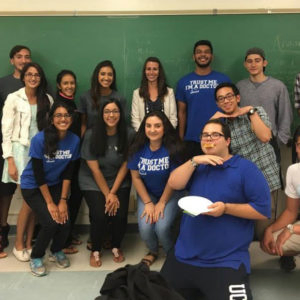Sample MCAT Question - Glycolysis Net Reaction
Which of the following products are created by glycolysis?
a) ADP
b) Glucose
c) Citrate
d) NADH
Get 1-on-1 MCAT Tutoring From a Specialist
With MCAT tutoring from MedSchoolCoach, we are committed to help you prepare, excel, and optimize your ideal score on the MCAT exam.
For each student we work with, we learn about their learning style, content knowledge, and goals. We match them with the most suitable tutor and conduct online sessions that make them feel as if they are in the classroom. Each session is recorded, plus with access to whiteboard notes. We focus on high-yield topics if you’re pressed for time. If you have more time or high-score goals, we meticulously cover the entire MCAT syllabus.
Glycolysis Net Reaction Summary
Glycolysis is a 10-step process that can be broken down into two phases, the preparatory phase (steps 1-5) and the payoff phase (steps 6-10). In the preparatory phase, glucose is broken down into two molecules of glyceraldehyde-3-phosphate, a process which requires an energy investment of two ATP molecules. In the payoff phase, the two glyceraldehyde-3-phosphate molecules are then converted into two pyruvate molecules, which results in the formation of four molecules of ATP and two molecules of NADH.
In summary, then, the net reaction of glycolysis is as follows:
Glucose + 2 NAD+ + 2 ADP + 2 Pi → 2 Pyruvate + 2 NADH + 2 H+ + 2 ATP + 2 H2O
Remember, in addition to NADH and ATP, pyruvate is also a high-energy molecule and can be broken down further to release energy. This occurs through the decarboxylation of pyruvate by pyruvate dehydrogenase complex, the entry of acetyl-CoA into the Krebs cycle, the oxidation of electron carriers and the build-up of a proton gradient in the electron transport chain, and finally the harnessing of that proton gradient by ATP synthase to create ATP. These processes, collectively known as aerobic respiration, produce about 34 more ATP molecules per glucose molecule, in addition to the two ATP formed through glycolysis.
Explore More
MCAT Masterclass Chapters
Take a closer look at our entire MCAT Masterclass or explore our Biochemistry lessons below.
-
MCAT Biochemistry
Glycolysis Part 2
View Subject -
MCAT Biochemistry
Pyruvate Dehydrogenase Complex
View Subject -
MCAT Biochemistry
Electron Transport Chain
View Subject -
MCAT Biochemistry
Glycolysis Part 1
View Subject -
MCAT Biochemistry
The Krebs Cycle
View Subject -
MCAT Biochemistry
Chemiosmotic Coupling & Proton Motive Force
View Subject




